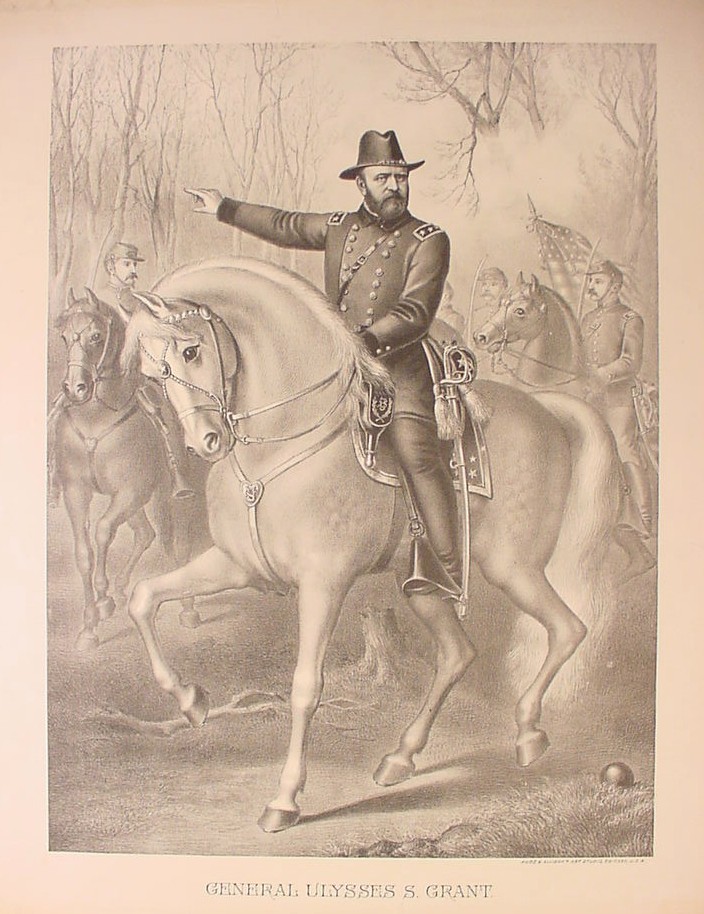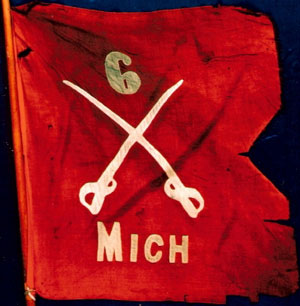Fall Colors on the Perry Tree
 FAMILY LEGEND TELLS of one of our ancestors, who marched with General Grant in the Civil War. To be more exact, he rode with him... as General Grant's flag bearer (color bearer). Apparently, being a Civil War color bearer was "the toughest job you'll ever love, but it will probably get you killed. Carrying a regiment's colors into battle was considered an honor and a privilege. It was also a very dangerous job and would likely get a man maimed or killed. Thus, it required a great deal of courage" (Civil War Sources Blog). Soldiers would look to the flag to maintain their position and to keep from being separated from their regiment. My uncle told me that one of General Grant’s color bearers was a "Flynn"—the maiden name of my maternal grandfather's mother—and that he was featured "in that famous sketch with General Grant on horseback," (as possibly the one pictured here in a lithograph by the Chicago firm, Kurz & Allison, ca. 1880).
FAMILY LEGEND TELLS of one of our ancestors, who marched with General Grant in the Civil War. To be more exact, he rode with him... as General Grant's flag bearer (color bearer). Apparently, being a Civil War color bearer was "the toughest job you'll ever love, but it will probably get you killed. Carrying a regiment's colors into battle was considered an honor and a privilege. It was also a very dangerous job and would likely get a man maimed or killed. Thus, it required a great deal of courage" (Civil War Sources Blog). Soldiers would look to the flag to maintain their position and to keep from being separated from their regiment. My uncle told me that one of General Grant’s color bearers was a "Flynn"—the maiden name of my maternal grandfather's mother—and that he was featured "in that famous sketch with General Grant on horseback," (as possibly the one pictured here in a lithograph by the Chicago firm, Kurz & Allison, ca. 1880).
In the footnotes of "Newaygo in the Civil War," it says that Andrew Flynn suffered saber cuts on both hands and jaw. I can picture Andrew charging into battle—perhaps carrying a flag—and getting thrown off his horse; he gets to his feet as an enemy saber swings towards him, and he throws his hands up to protect his face just in time, dropping the flag, but saving his own life by blocking the saber with both hand, as it strikes his jaw. He transferred to the US Navy on April 14, 1864 on the auxiliary ship "North Carolina," (Record of service of Michigan volunteers in the Civil War, 1861-1865, Volume 36, p. 55).
So, I ache to answer these questions:
- Are there sources to determine who were the regiments' color bearers?
- Andrew Flynn enlisted as a "Private" (of course?): Were Privates color bearers?
- Was Andrew Flynn ever led (along with the 6th Michigan Cavalry) by General Grant himself?
- Did Andrew Flynn know General Custer?
- Was Andrew Flynn indeed a color bearer?
- Is there such a thing as Civil War medical records to scour?
Now where did my uncle get his "legendary" information? How did this family legend get started? I have only uncovered a few clues about Andrew Flynn. With a few morsels of imagination, I take liberties to come up with a likely bio... (Please don't take this as history; I'm reading between the lines, and my goal is to be clear as to what's fact and what's hypothesis, and I allow your intelligence to decipher where I'm blowing smoke.)
Andrew Flynn was born in Port Hope, Ontario, Canada in 1831 to his Irish parents, James Joseph O’Flynn and Mary Ann Workman. At the age of 23, Andrew left his family to come to the United States; the US Naturalization Records Index finds an "Andrew Flynn" in Pennsylvania in October of 1854—naturalized on the 10th, heretofore as a subject of Queen Victoria. From Pennsylvania, Andrew made his way to Michigan, where he lived alone, working as a "Laborer" (1860 US Census, Township of Ensley, Newaygo County). Most of his neighbors were farmers, and perhaps he labored for one of them, although the document "Productions of Agriculture in Township of Ensley..." (page 1) lists him as owning 80 acres of land—20 of which were plowed by two oxen to produce wheat and Indian corn.
Alone on the farm (with two oxen for company), Andrew's privacy was important to him. He didn't want people to know he was Canadian, perhaps because of national tensions on the cusp of the Civil War. He even told the Census enumerator that he was born in Michigan. Or perhaps he was covering up a scandal... Yeah, it seems he was "plowing other fields" in Grattan Township, where an Esther Clark lived. She was barely legal (by today's standards)—18 years old last February! Perhaps it was a good thing her father had been dead for three years.
By the time the crops were ready for harvest, Esther was pregnant. So he married her that winter (December 2). In the spring of 1861, new crops should have been planted, but Andrew lay his wife and stillborn child in the ground instead. It appears that Esther died from complications of her baby's delivery. The Clark family had it rough that year: Mom died in February, as did two of Esther's siblings that year. Perhaps they all died of disease, including Esther and the baby.
It took some time for Andrew to regain his footing. A year later, Civil War broke out, and he enlisted. He fought hard and plenty and made it home wounded but alive in June, 1865. By this time, he figured he had proven himself (to the Nation, no less) and figured he was entitled to go get what he wanted... even if she was only 14 years old. She, Persis Merritt, was 15 years old, when he married her on December 1, 1866 (a day before his previous wedding anniversary). Their first child was born the next year—likely between August and December, since she's said to be two years old (almost three) on the 1870 Census, where Andrew finally claims to be a farmer born in Canada (and two years younger than we know him really to be).
The strange thing is that there is someone else living with him and Persis in 1870... not just Fanny their daughter and James their son, but also a William Clark (age 15). Uh oh... Who is that?! He would have been born in 1855, right after the lonesome Andrew Flynn came to the States and met Esther Clark. Might William be the illegitimate child between Esther and Andrew but hid his identity because of her age, status (and of course, because the daddy was Canadian)? Was William the love-child now restored to his father's house after Andrew had proven himself?
I need to find death certificates for more details (if they exist)!
Well, it seems Andrew and his large family of eight (or was it actually 9?) children lived happy and prosperous lives for many years. Andrew Flynn was even elected Treasurer of Ensley Township in 1888. I wonder how his life affected his children's lives—namely, Ernest's (my 2x great grandfather). What war stories were proudly told and passed down? His first grandchild, Mary Augusta Flynn (my great grandmother), hardly got to know him (Grandpa Andrew died when she was six years old), but I imagine she heard stories, as well as had tales to tell of her own.
Gotta keep digging.


